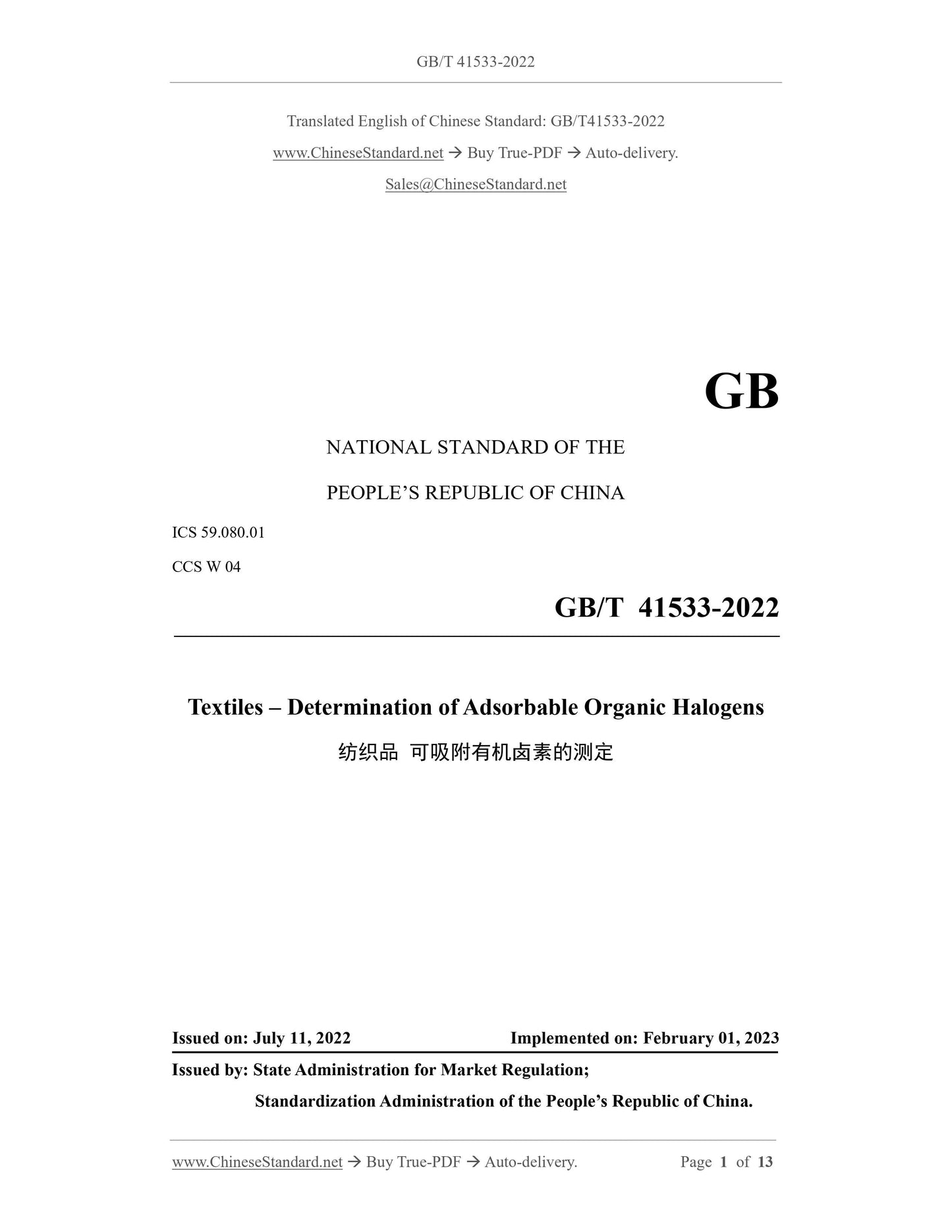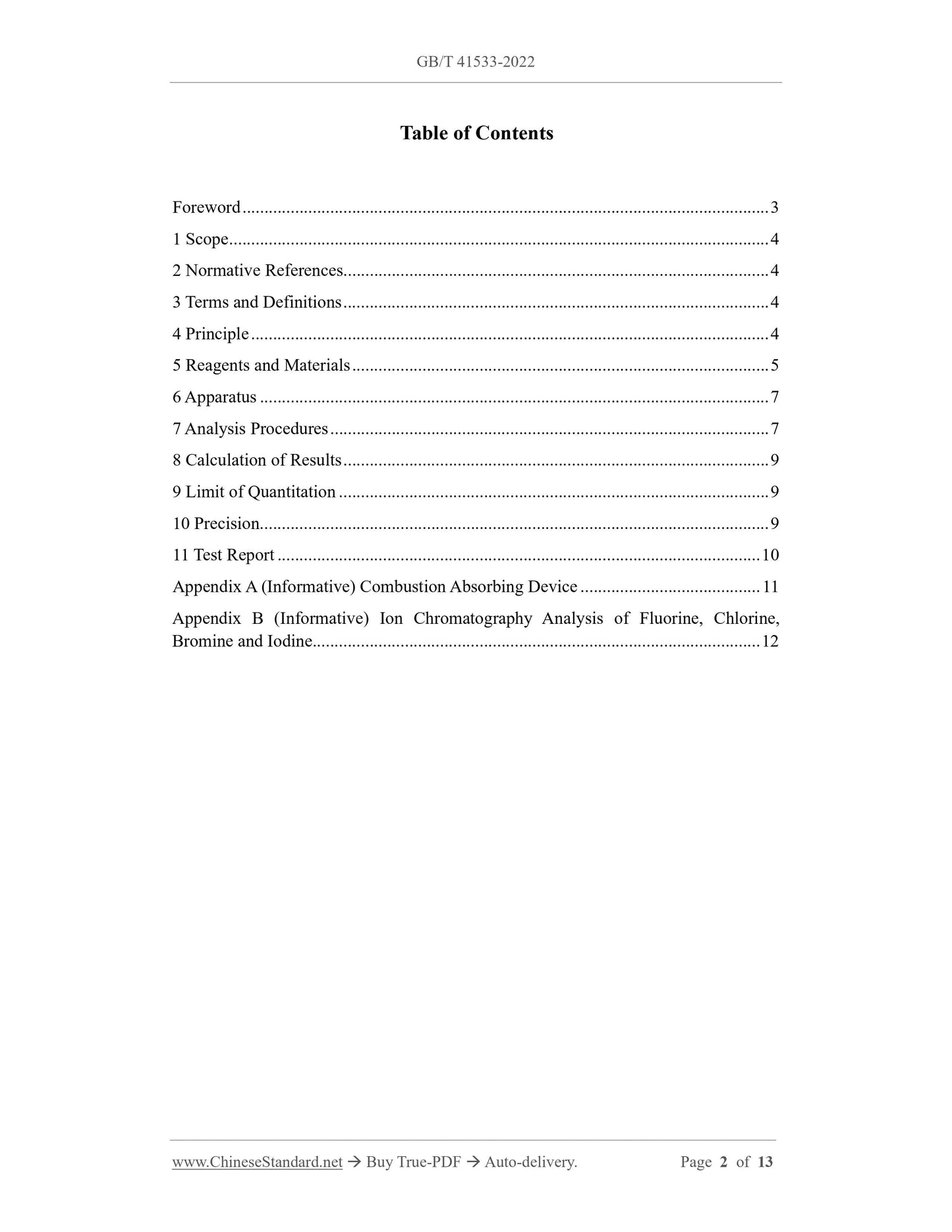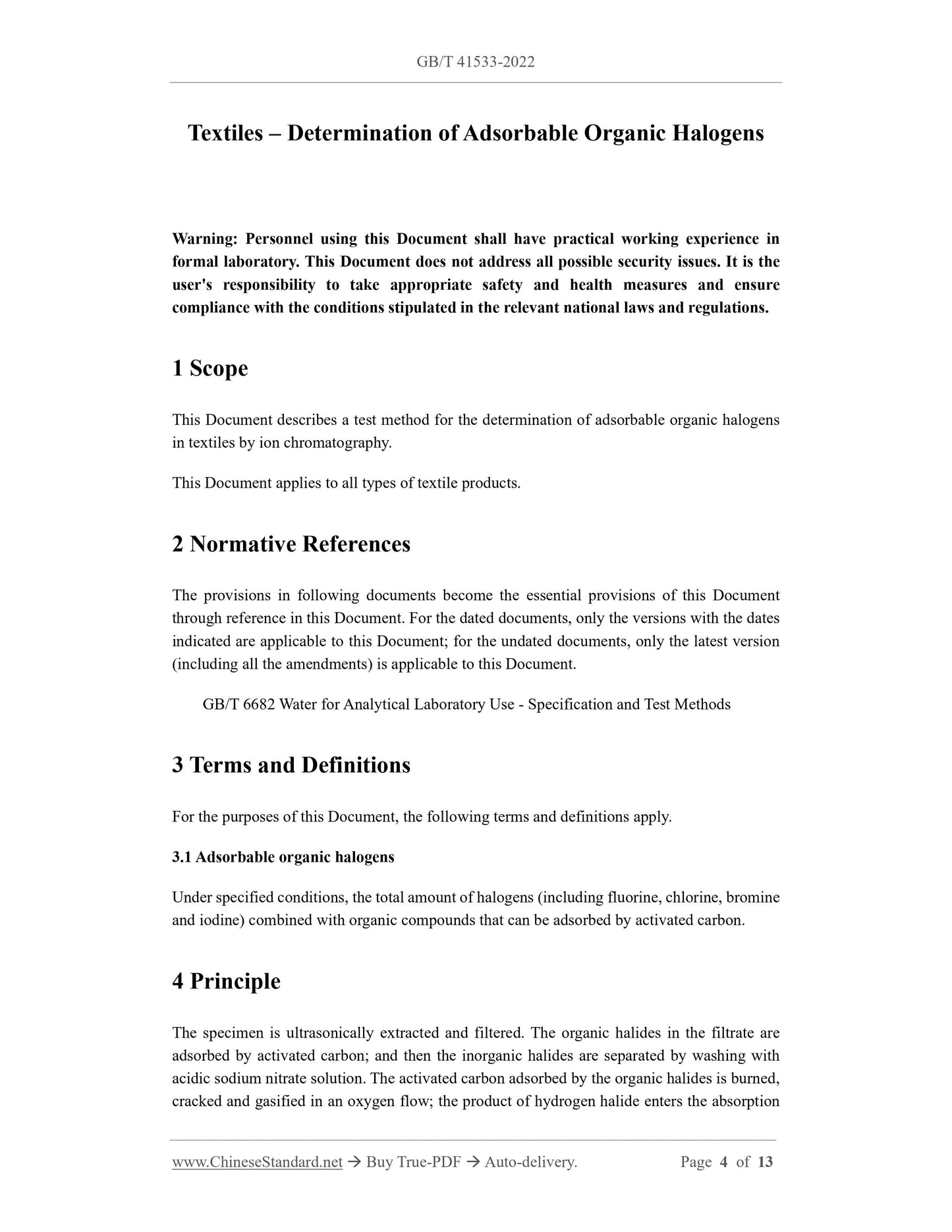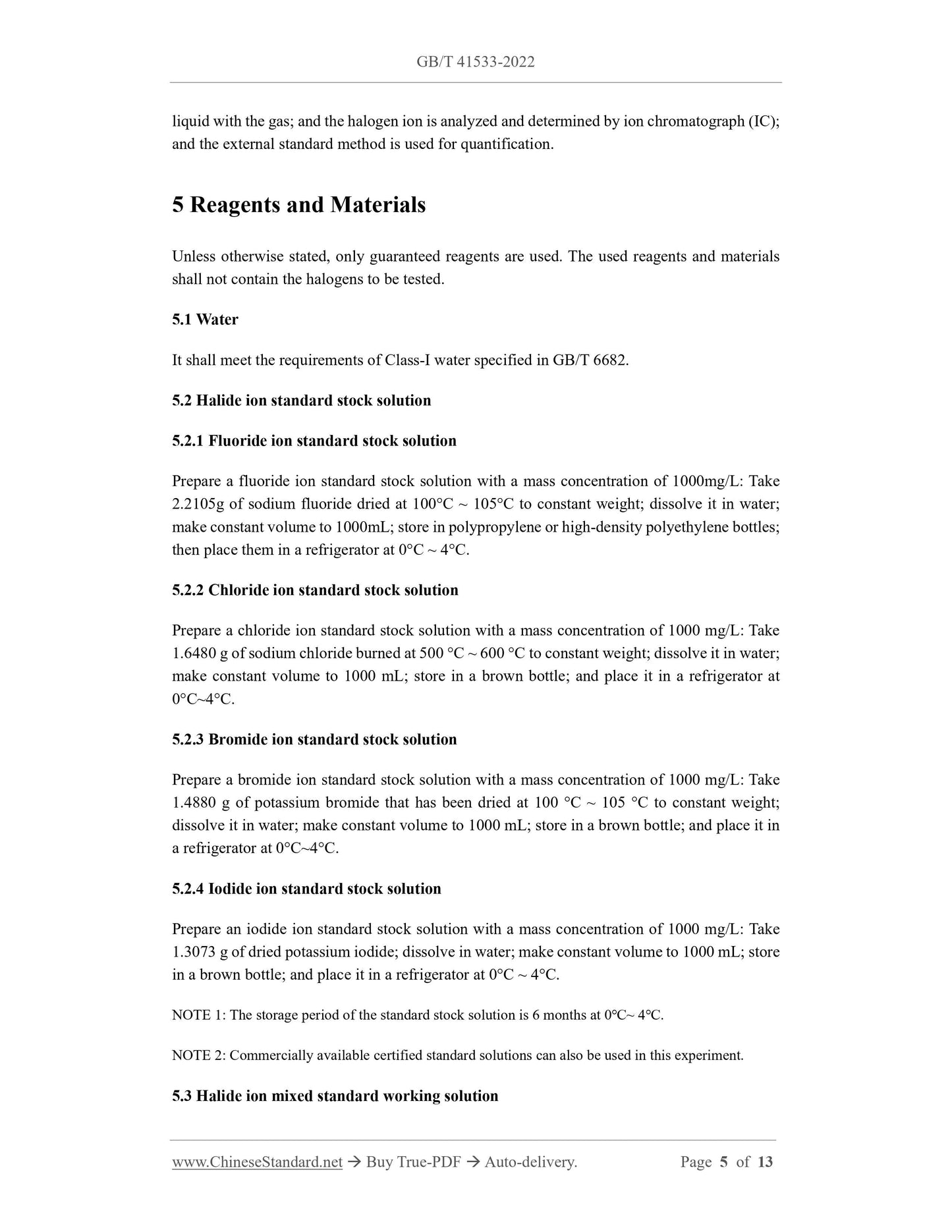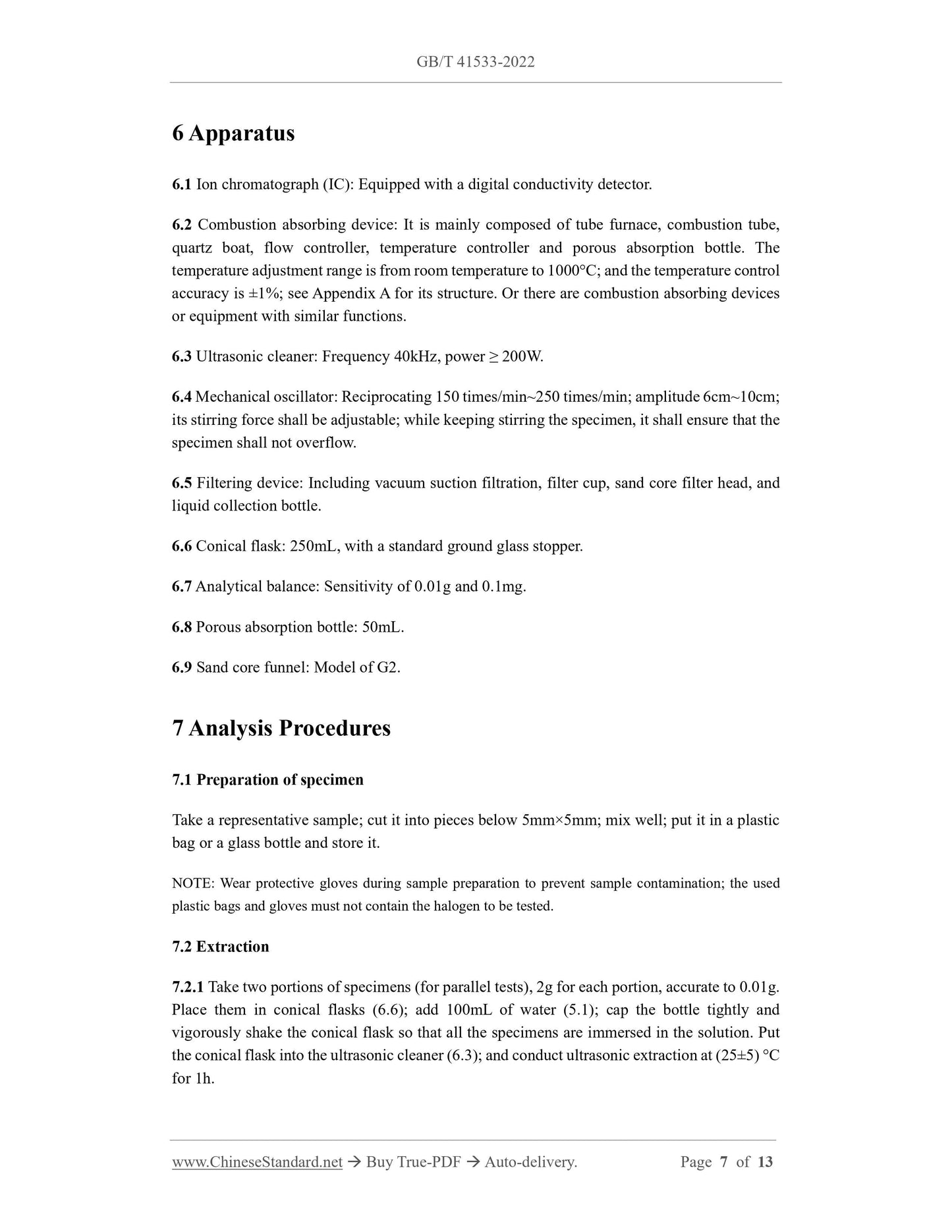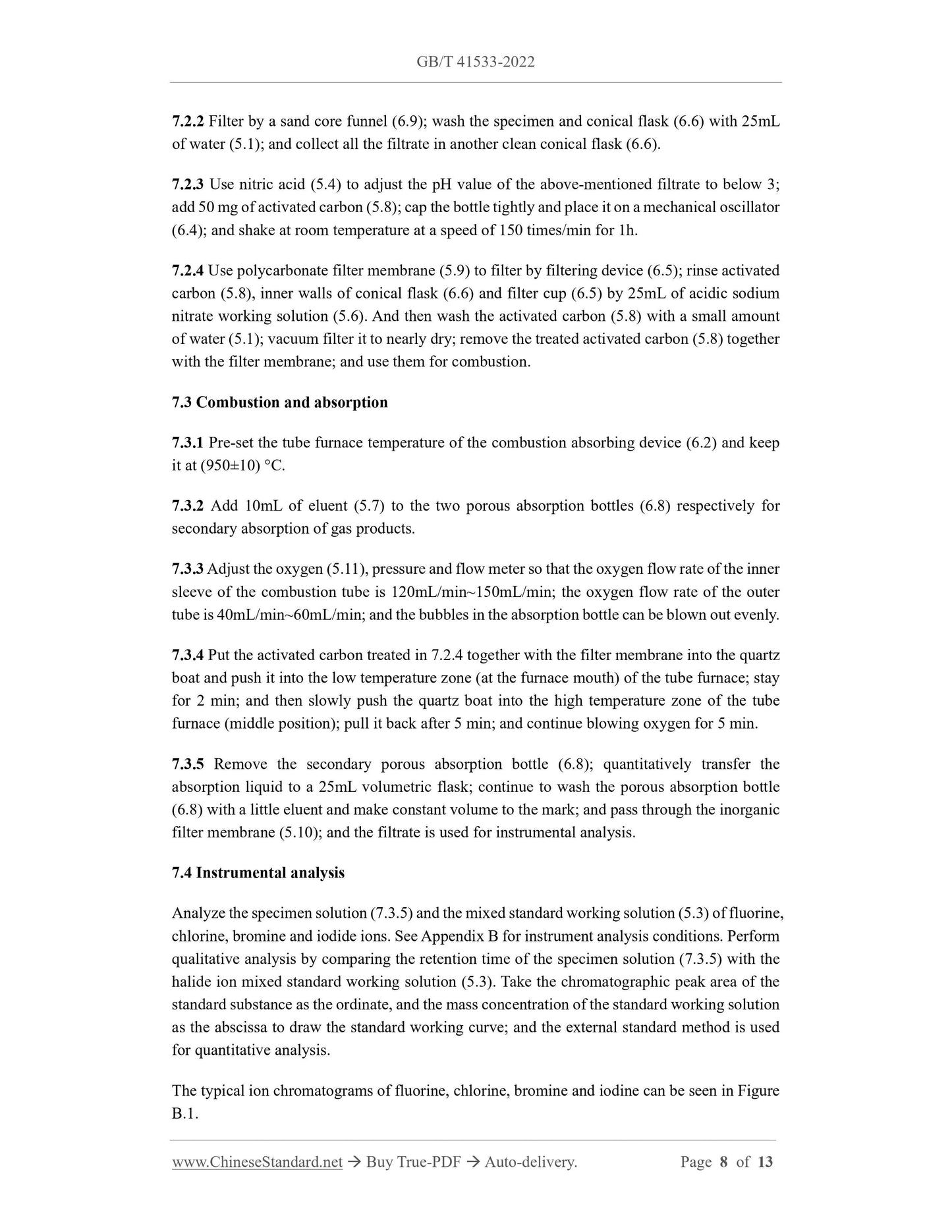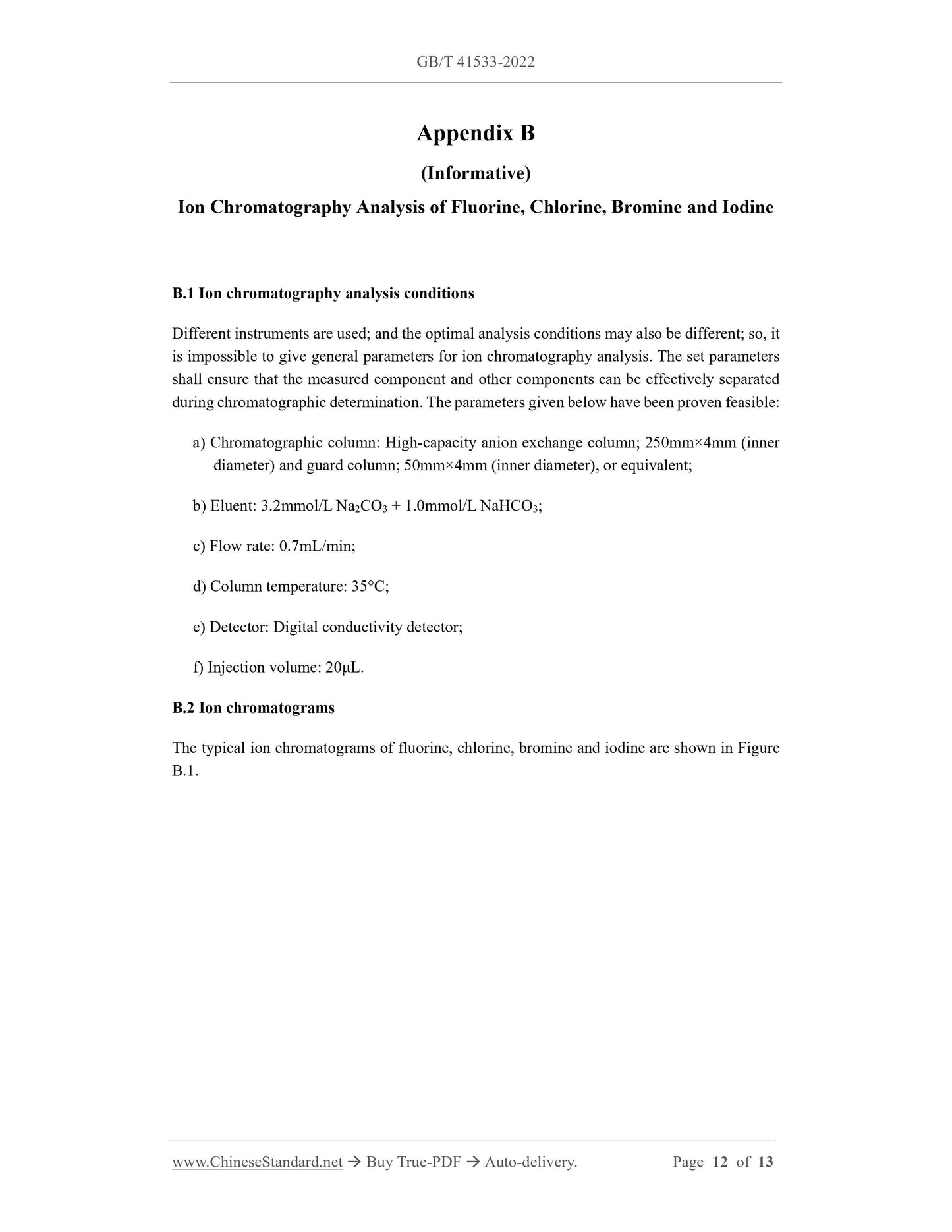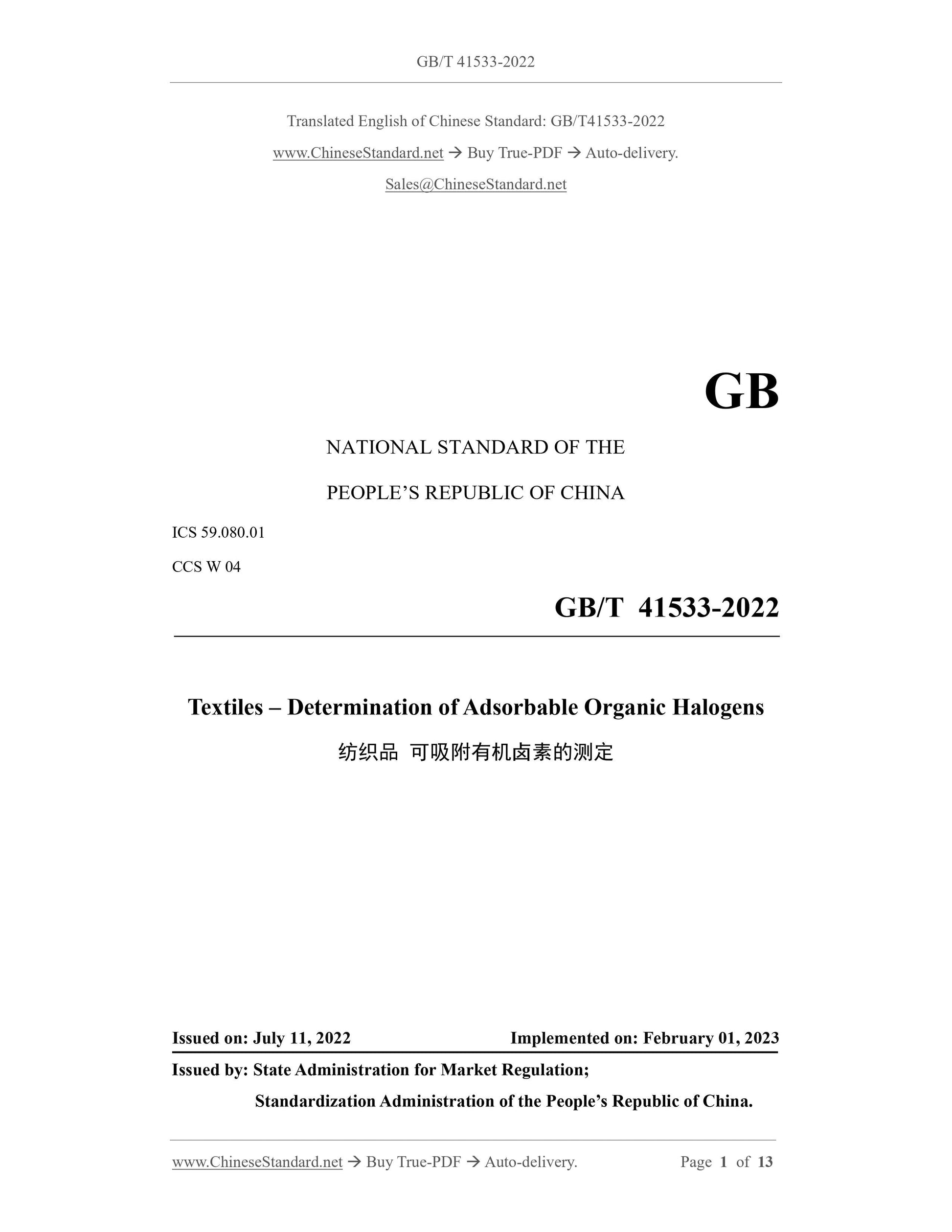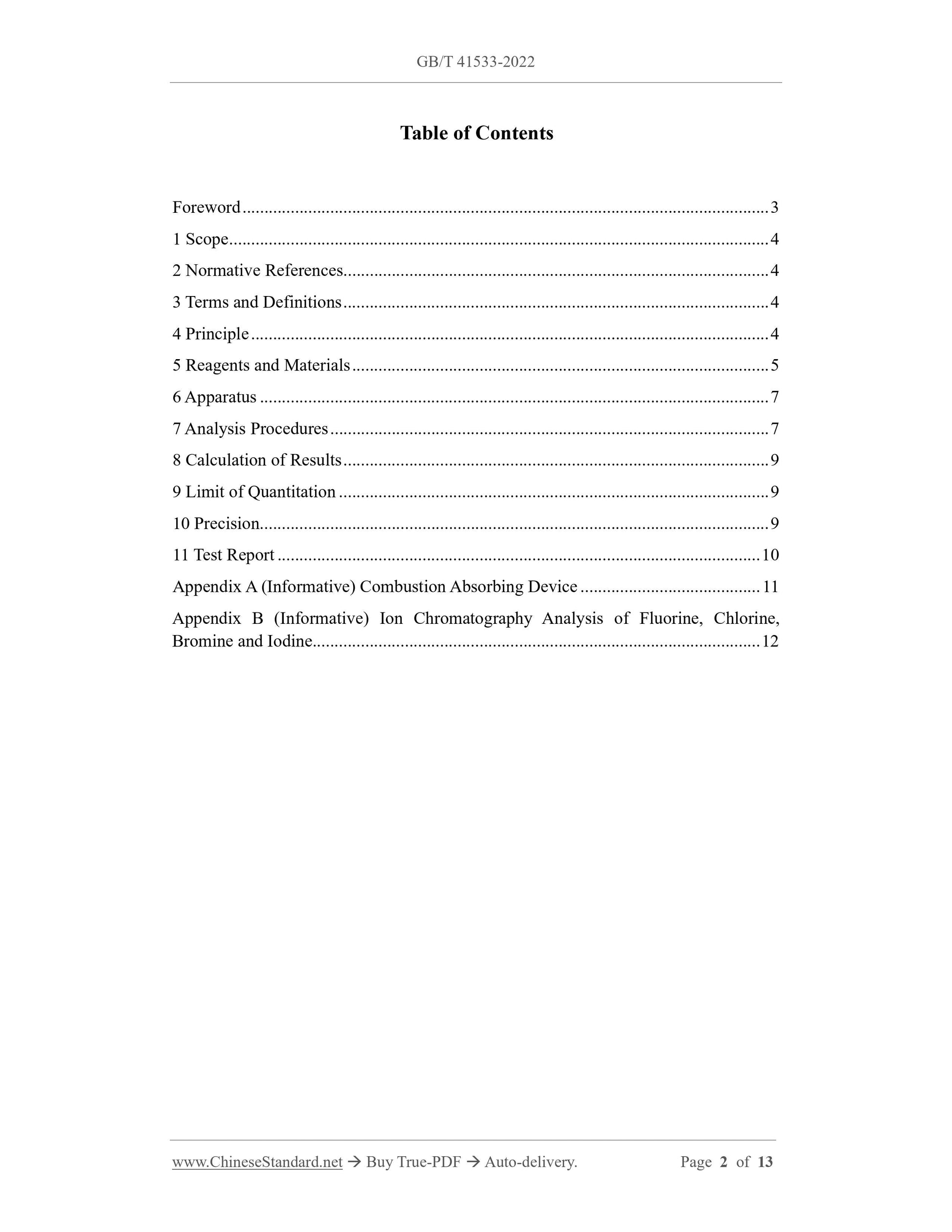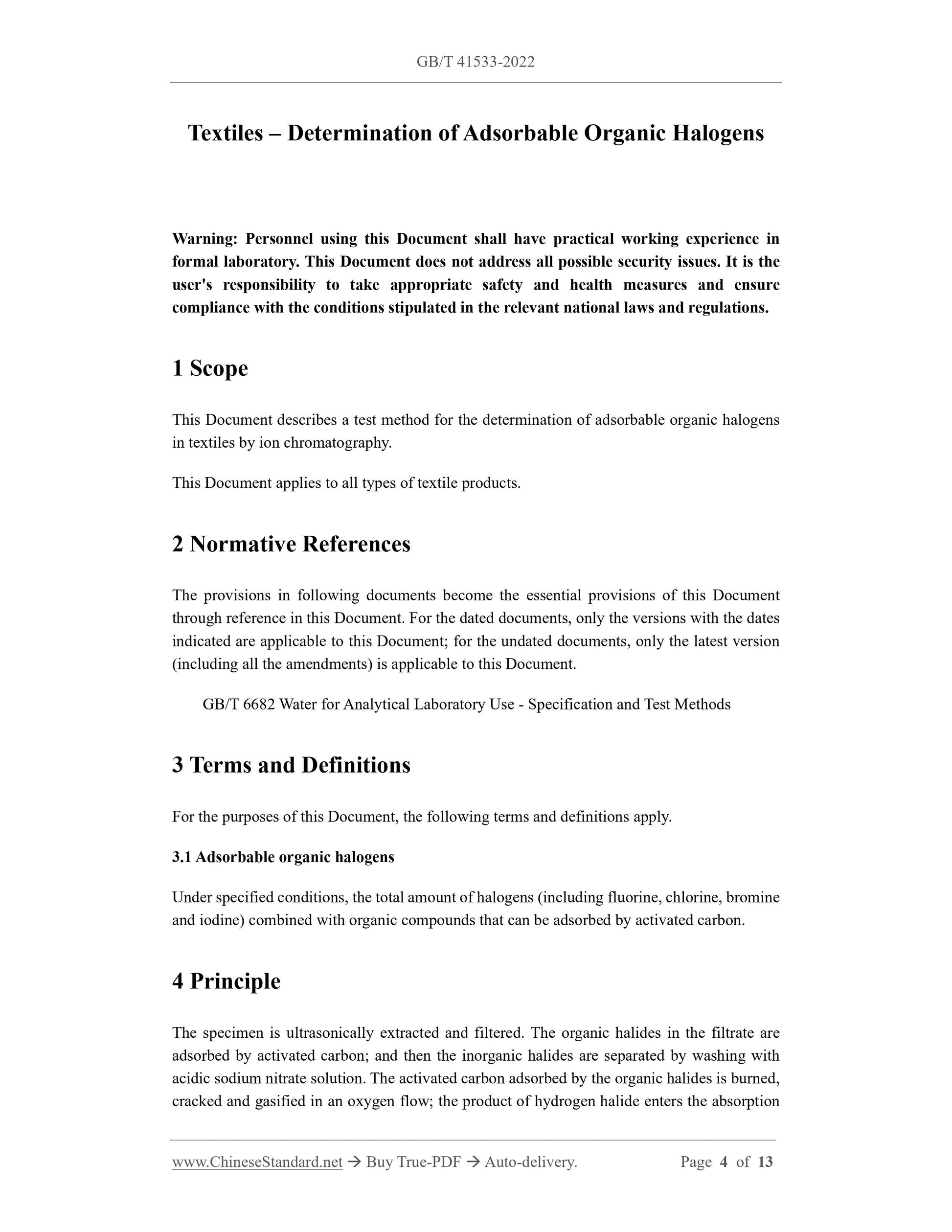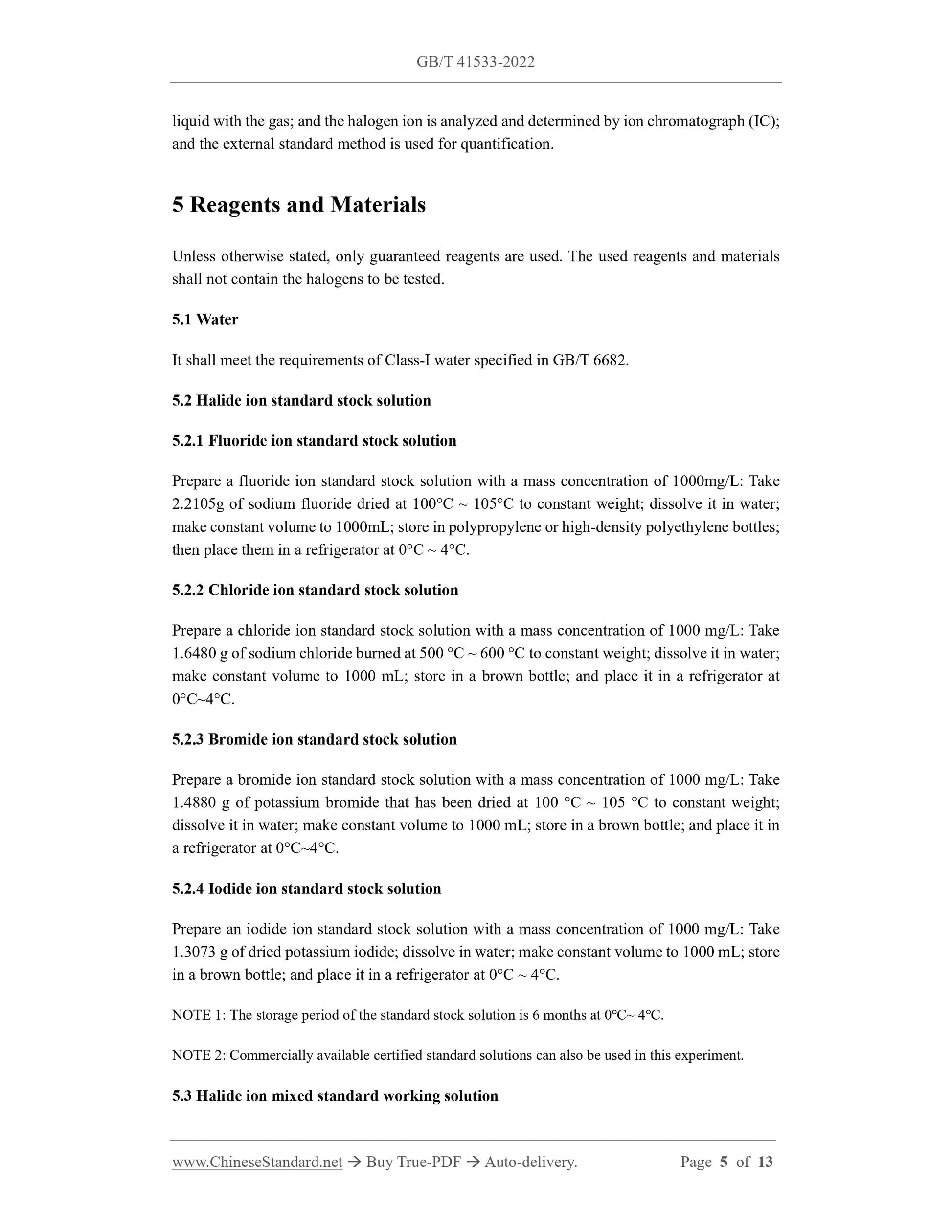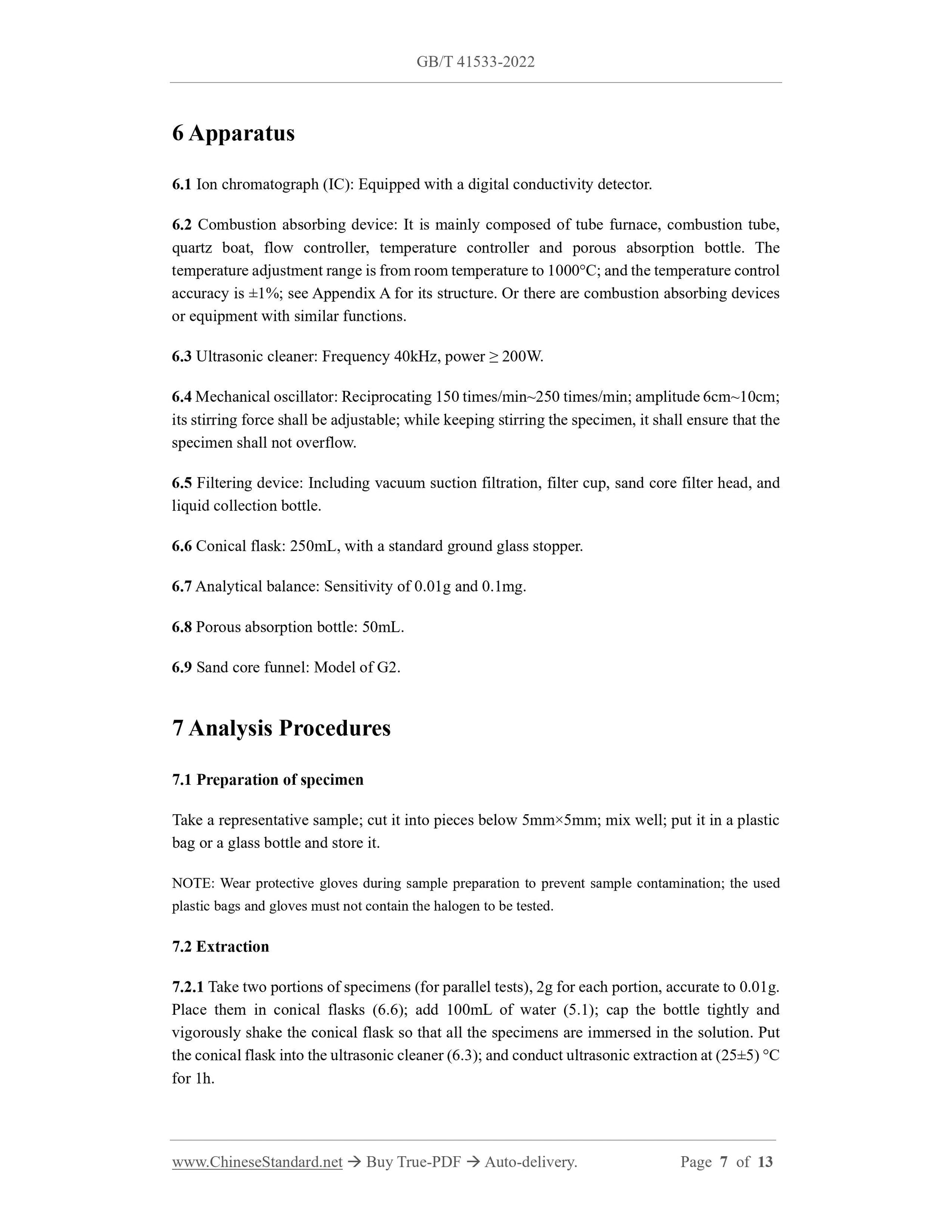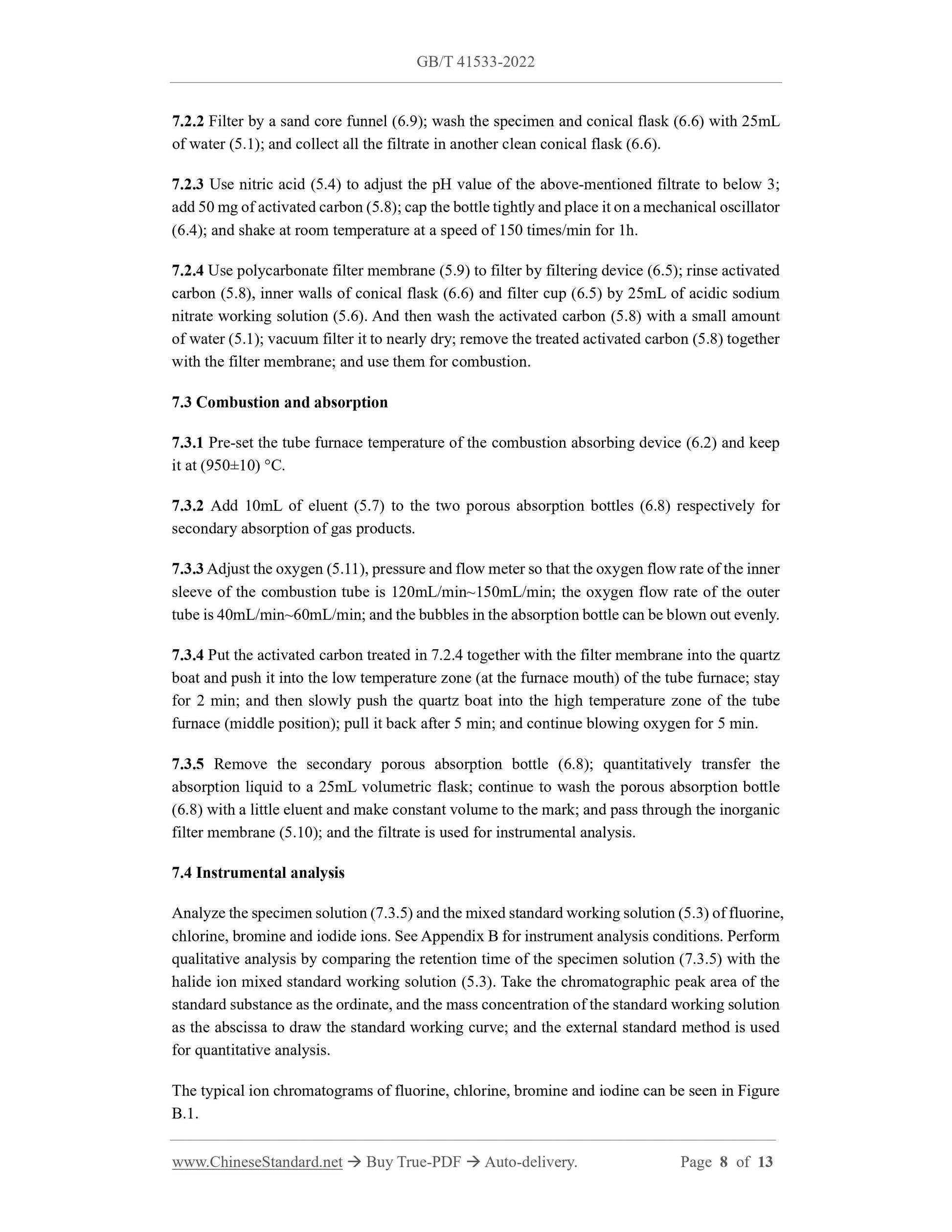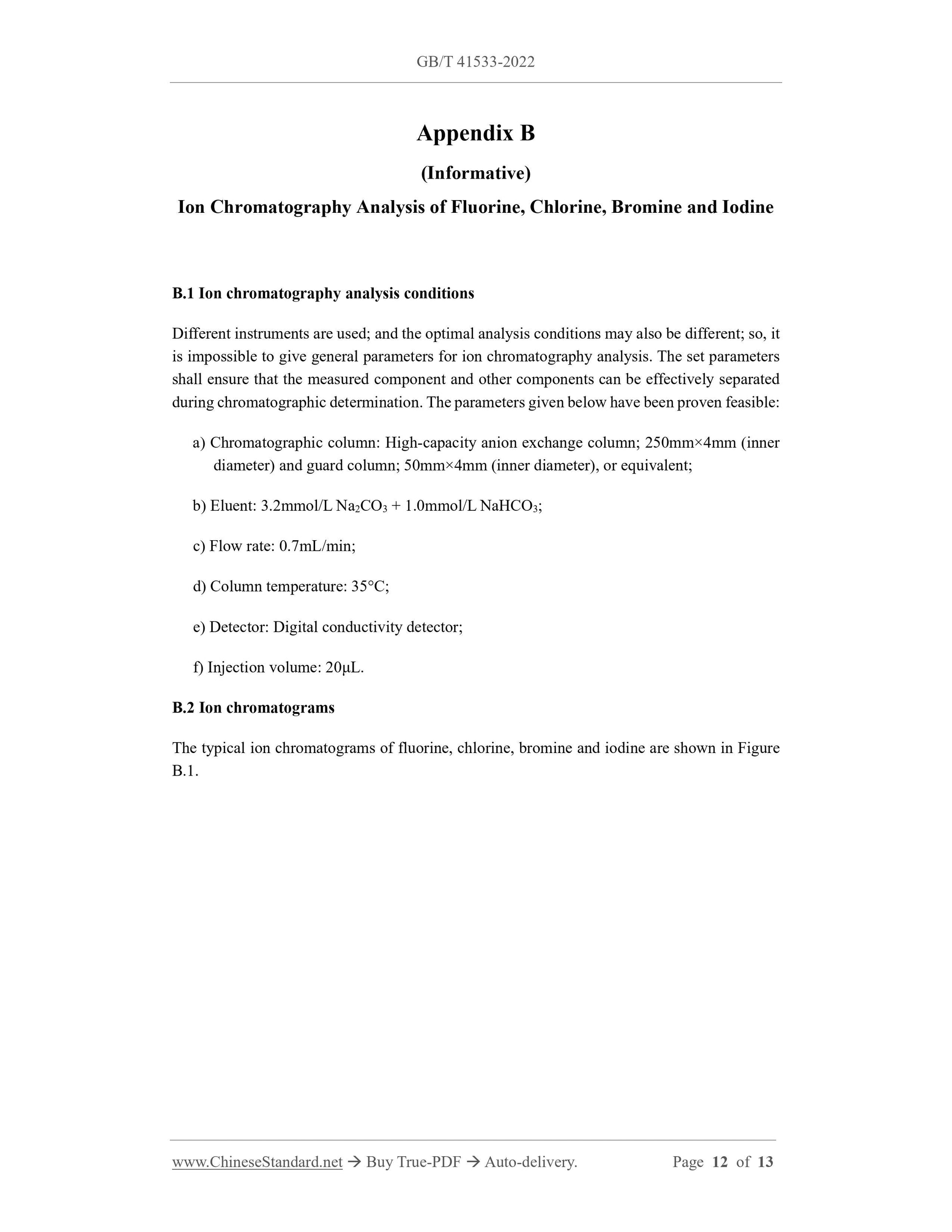1
/
of
7
PayPal, credit cards. Download editable-PDF & invoice in 1 second!
GB/T 41533-2022 English PDF (GBT41533-2022)
GB/T 41533-2022 English PDF (GBT41533-2022)
Regular price
$185.00 USD
Regular price
Sale price
$185.00 USD
Unit price
/
per
Shipping calculated at checkout.
Couldn't load pickup availability
Delivery: 3 seconds. Download true-PDF + Invoice.
Get QUOTATION in 1-minute: Click GB/T 41533-2022
Historical versions: GB/T 41533-2022
Preview True-PDF (Reload/Scroll if blank)
GB/T 41533-2022: Textiles - Determination of adsorbable organic halogens
GB/T 41533-2022
GB
NATIONAL STANDARD OF THE
PEOPLE’S REPUBLIC OF CHINA
ICS 59.080.01
CCS W 04
Textiles – Determination of Adsorbable Organic Halogens
ISSUED ON: JULY 11, 2022
IMPLEMENTED ON: FEBRUARY 01, 2023
Issued by: State Administration for Market Regulation;
Standardization Administration of the People’s Republic of China.
Table of Contents
Foreword ... 3
1 Scope ... 4
2 Normative References ... 4
3 Terms and Definitions ... 4
4 Principle ... 4
5 Reagents and Materials ... 5
6 Apparatus ... 7
7 Analysis Procedures ... 7
8 Calculation of Results ... 9
9 Limit of Quantitation ... 9
10 Precision ... 9
11 Test Report ... 10
Appendix A (Informative) Combustion Absorbing Device ... 11
Appendix B (Informative) Ion Chromatography Analysis of Fluorine, Chlorine,
Bromine and Iodine... 12
Textiles – Determination of Adsorbable Organic Halogens
Warning: Personnel using this Document shall have practical working experience in
formal laboratory. This Document does not address all possible security issues. It is the
user's responsibility to take appropriate safety and health measures and ensure
compliance with the conditions stipulated in the relevant national laws and regulations.
1 Scope
This Document describes a test method for the determination of adsorbable organic halogens
in textiles by ion chromatography.
This Document applies to all types of textile products.
2 Normative References
The provisions in following documents become the essential provisions of this Document
through reference in this Document. For the dated documents, only the versions with the dates
indicated are applicable to this Document; for the undated documents, only the latest version
(including all the amendments) is applicable to this Document.
GB/T 6682 Water for Analytical Laboratory Use - Specification and Test Methods
3 Terms and Definitions
For the purposes of this Document, the following terms and definitions apply.
3.1 Adsorbable organic halogens
Under specified conditions, the total amount of halogens (including fluorine, chlorine, bromine
and iodine) combined with organic compounds that can be adsorbed by activated carbon.
4 Principle
The specimen is ultrasonically extracted and filtered. The organic halides in the filtrate are
adsorbed by activated carbon; and then the inorganic halides are separated by washing with
acidic sodium nitrate solution. The activated carbon adsorbed by the organic halides is burned,
cracked and gasified in an oxygen flow; the product of hydrogen halide enters the absorption
liquid with the gas; and the halogen ion is analyzed and determined by ion chromatograph (IC);
and the external standard method is used for quantification.
5 Reagents and Materials
Unless otherwise stated, only guaranteed reagents are used. The used reagents and materials
shall not contain the halogens to be tested.
5.1 Water
It shall meet the requirements of Class-I water specified in GB/T 6682.
5.2 Halide ion standard stock solution
5.2.1 Fluoride ion standard stock solution
Prepare a fluoride ion standard stock solution with a mass concentration of 1000mg/L: Take
2.2105g of sodium fluoride dried at 100°C ~ 105°C to constant weight; dissolve it in water;
make constant volume to 1000mL; store in polypropylene or high-density polyethylene bottles;
then place them in a refrigerator at 0°C ~ 4°C.
5.2.2 Chloride ion standard stock solution
Prepare a chloride ion standard stock solution with a mass concentration of 1000 mg/L: Take
1.6480 g of sodium chloride burned at 500 °C ~ 600 °C to constant weight; dissolve it in water;
make constant volume to 1000 mL; store in a brown bottle; and place it in a refrigerator at
0°C~4°C.
5.2.3 Bromide ion standard stock solution
Prepare a bromide ion standard stock solution with a mass concentration of 1000 mg/L: Take
1.4880 g of potassium bromide that has been dried at 100 °C ~ 105 °C to constant weight;
dissolve it in water; make constant volume to 1000 mL; store in a brown bottle; and place it in
a refrigerator at 0°C~4°C.
5.2.4 Iodide ion standard stock solution
Prepare an iodide ion standard stock solution with a mass concentration of 1000 mg/L: Take
1.3073 g of dried potassium iodide; dissolve in water; make constant volume to 1000 mL; store
in a brown bottle; and place it in a refrigerator at 0°C ~ 4°C.
NOTE 1: The storage period of the standard stock solution is 6 months at 0℃~ 4℃.
NOTE 2: Commercially available certified standard solutions can also be used in this experiment.
5.3 Halide ion mixed standard working solution
6 Apparatus
6.1 Ion chromatograph (IC): Equipped with a digital conductivity detector.
6.2 Combustion absorbing device: It is mainly composed of tube furnace, combustion tube,
quartz boat, flow controller, temperature controller and porous absorption bottle. The
temperature adjustment range is from room temperature to 1000°C; and the temperature control
accuracy is ±1%; see Appendix A for its structure. Or there are combustion absorbing devices
or equipment with similar functions.
6.3 Ultrasonic cleaner: Frequency 40kHz, power ≥ 200W.
6.4 Mechanical oscillator: Reciprocating 150 times/min~250 times/min; amplitude 6cm~10cm;
its stirring force shall be adjustable; while keeping stirring the specimen, it shall ensure that the
specimen shall not overflow.
6.5 Filtering device: Including vacuum suction filtration, filter cup, sand core filter head, and
liquid collection bottle.
6.6 Conical flask: 250mL, with a standard ground glass stopper.
6.7 Analytical balance: Sensitivity of 0.01g and 0.1mg.
6.8 Porous absorption bottle: 50mL.
6.9 Sand core funnel: Model of G2.
7 Analysis Procedures
7.1 Preparation of specimen
Take a representative sample; cut it into pieces below 5mm×5mm; mix well; put it in a plastic
bag or a glass bottle and store it.
NOTE: Wear protective gloves during sample preparation to prevent sample contamination; the used
plastic bags and gloves must not contain the halogen to be tested.
7.2 Extraction
7.2.1 Take two portions of specimens (for parallel tests), 2g for each portion, accurate to 0.01g.
Place them in conical flasks (6.6); add 100mL of water (5.1); cap the bottle tightly and
vigorously shake the conical flask so that all the specimens are immersed in the solution. Put
the conical flask into the ultrasonic cleaner (6.3); and conduct ultrasonic extraction at (25±5) °C
for 1h.
7.2.2 Filter by a sand core funnel (6.9); wash the specimen and conical flask (6.6) with 25mL
of water (5.1); and collect all the filtrate in another clean conical flask (6.6).
7.2.3 Use nitric acid (5.4) to adjust the pH value of the above-mentioned filtrate to below 3;
add 50 mg of activated carbon (5.8); cap the bottle tightly and place it on a mechanical oscillator
(6.4); and shake at room temperature at a speed of 150 times/min for 1h.
7.2.4 Use polycarbonate filter membrane (5.9) to filter by filtering device (6.5); rinse activated
carbon (5.8), inner walls of conical flask (6.6) and filter cup (6.5) by 25mL of acidic sodium
nitrate working solution (5.6). And then wash the activated carbon (5.8) with a small amount
of water (5.1); vacuum filter it to nearly dry; remove the treated activated carbon (5.8) together
with the filter membrane; and use them for combustion.
7.3 Combustion and absorption
7.3.1 Pre-set the tube furnace temperature of the combustion absorbing device (6.2) and keep
it at (950±10) °C.
7.3...
Get QUOTATION in 1-minute: Click GB/T 41533-2022
Historical versions: GB/T 41533-2022
Preview True-PDF (Reload/Scroll if blank)
GB/T 41533-2022: Textiles - Determination of adsorbable organic halogens
GB/T 41533-2022
GB
NATIONAL STANDARD OF THE
PEOPLE’S REPUBLIC OF CHINA
ICS 59.080.01
CCS W 04
Textiles – Determination of Adsorbable Organic Halogens
ISSUED ON: JULY 11, 2022
IMPLEMENTED ON: FEBRUARY 01, 2023
Issued by: State Administration for Market Regulation;
Standardization Administration of the People’s Republic of China.
Table of Contents
Foreword ... 3
1 Scope ... 4
2 Normative References ... 4
3 Terms and Definitions ... 4
4 Principle ... 4
5 Reagents and Materials ... 5
6 Apparatus ... 7
7 Analysis Procedures ... 7
8 Calculation of Results ... 9
9 Limit of Quantitation ... 9
10 Precision ... 9
11 Test Report ... 10
Appendix A (Informative) Combustion Absorbing Device ... 11
Appendix B (Informative) Ion Chromatography Analysis of Fluorine, Chlorine,
Bromine and Iodine... 12
Textiles – Determination of Adsorbable Organic Halogens
Warning: Personnel using this Document shall have practical working experience in
formal laboratory. This Document does not address all possible security issues. It is the
user's responsibility to take appropriate safety and health measures and ensure
compliance with the conditions stipulated in the relevant national laws and regulations.
1 Scope
This Document describes a test method for the determination of adsorbable organic halogens
in textiles by ion chromatography.
This Document applies to all types of textile products.
2 Normative References
The provisions in following documents become the essential provisions of this Document
through reference in this Document. For the dated documents, only the versions with the dates
indicated are applicable to this Document; for the undated documents, only the latest version
(including all the amendments) is applicable to this Document.
GB/T 6682 Water for Analytical Laboratory Use - Specification and Test Methods
3 Terms and Definitions
For the purposes of this Document, the following terms and definitions apply.
3.1 Adsorbable organic halogens
Under specified conditions, the total amount of halogens (including fluorine, chlorine, bromine
and iodine) combined with organic compounds that can be adsorbed by activated carbon.
4 Principle
The specimen is ultrasonically extracted and filtered. The organic halides in the filtrate are
adsorbed by activated carbon; and then the inorganic halides are separated by washing with
acidic sodium nitrate solution. The activated carbon adsorbed by the organic halides is burned,
cracked and gasified in an oxygen flow; the product of hydrogen halide enters the absorption
liquid with the gas; and the halogen ion is analyzed and determined by ion chromatograph (IC);
and the external standard method is used for quantification.
5 Reagents and Materials
Unless otherwise stated, only guaranteed reagents are used. The used reagents and materials
shall not contain the halogens to be tested.
5.1 Water
It shall meet the requirements of Class-I water specified in GB/T 6682.
5.2 Halide ion standard stock solution
5.2.1 Fluoride ion standard stock solution
Prepare a fluoride ion standard stock solution with a mass concentration of 1000mg/L: Take
2.2105g of sodium fluoride dried at 100°C ~ 105°C to constant weight; dissolve it in water;
make constant volume to 1000mL; store in polypropylene or high-density polyethylene bottles;
then place them in a refrigerator at 0°C ~ 4°C.
5.2.2 Chloride ion standard stock solution
Prepare a chloride ion standard stock solution with a mass concentration of 1000 mg/L: Take
1.6480 g of sodium chloride burned at 500 °C ~ 600 °C to constant weight; dissolve it in water;
make constant volume to 1000 mL; store in a brown bottle; and place it in a refrigerator at
0°C~4°C.
5.2.3 Bromide ion standard stock solution
Prepare a bromide ion standard stock solution with a mass concentration of 1000 mg/L: Take
1.4880 g of potassium bromide that has been dried at 100 °C ~ 105 °C to constant weight;
dissolve it in water; make constant volume to 1000 mL; store in a brown bottle; and place it in
a refrigerator at 0°C~4°C.
5.2.4 Iodide ion standard stock solution
Prepare an iodide ion standard stock solution with a mass concentration of 1000 mg/L: Take
1.3073 g of dried potassium iodide; dissolve in water; make constant volume to 1000 mL; store
in a brown bottle; and place it in a refrigerator at 0°C ~ 4°C.
NOTE 1: The storage period of the standard stock solution is 6 months at 0℃~ 4℃.
NOTE 2: Commercially available certified standard solutions can also be used in this experiment.
5.3 Halide ion mixed standard working solution
6 Apparatus
6.1 Ion chromatograph (IC): Equipped with a digital conductivity detector.
6.2 Combustion absorbing device: It is mainly composed of tube furnace, combustion tube,
quartz boat, flow controller, temperature controller and porous absorption bottle. The
temperature adjustment range is from room temperature to 1000°C; and the temperature control
accuracy is ±1%; see Appendix A for its structure. Or there are combustion absorbing devices
or equipment with similar functions.
6.3 Ultrasonic cleaner: Frequency 40kHz, power ≥ 200W.
6.4 Mechanical oscillator: Reciprocating 150 times/min~250 times/min; amplitude 6cm~10cm;
its stirring force shall be adjustable; while keeping stirring the specimen, it shall ensure that the
specimen shall not overflow.
6.5 Filtering device: Including vacuum suction filtration, filter cup, sand core filter head, and
liquid collection bottle.
6.6 Conical flask: 250mL, with a standard ground glass stopper.
6.7 Analytical balance: Sensitivity of 0.01g and 0.1mg.
6.8 Porous absorption bottle: 50mL.
6.9 Sand core funnel: Model of G2.
7 Analysis Procedures
7.1 Preparation of specimen
Take a representative sample; cut it into pieces below 5mm×5mm; mix well; put it in a plastic
bag or a glass bottle and store it.
NOTE: Wear protective gloves during sample preparation to prevent sample contamination; the used
plastic bags and gloves must not contain the halogen to be tested.
7.2 Extraction
7.2.1 Take two portions of specimens (for parallel tests), 2g for each portion, accurate to 0.01g.
Place them in conical flasks (6.6); add 100mL of water (5.1); cap the bottle tightly and
vigorously shake the conical flask so that all the specimens are immersed in the solution. Put
the conical flask into the ultrasonic cleaner (6.3); and conduct ultrasonic extraction at (25±5) °C
for 1h.
7.2.2 Filter by a sand core funnel (6.9); wash the specimen and conical flask (6.6) with 25mL
of water (5.1); and collect all the filtrate in another clean conical flask (6.6).
7.2.3 Use nitric acid (5.4) to adjust the pH value of the above-mentioned filtrate to below 3;
add 50 mg of activated carbon (5.8); cap the bottle tightly and place it on a mechanical oscillator
(6.4); and shake at room temperature at a speed of 150 times/min for 1h.
7.2.4 Use polycarbonate filter membrane (5.9) to filter by filtering device (6.5); rinse activated
carbon (5.8), inner walls of conical flask (6.6) and filter cup (6.5) by 25mL of acidic sodium
nitrate working solution (5.6). And then wash the activated carbon (5.8) with a small amount
of water (5.1); vacuum filter it to nearly dry; remove the treated activated carbon (5.8) together
with the filter membrane; and use them for combustion.
7.3 Combustion and absorption
7.3.1 Pre-set the tube furnace temperature of the combustion absorbing device (6.2) and keep
it at (950±10) °C.
7.3...
Share
